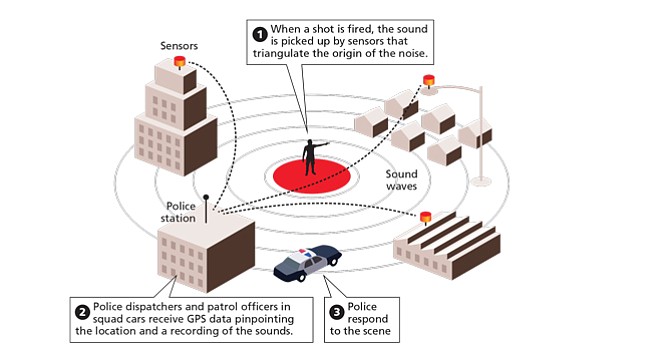 Facebook
Facebook
 X
X
 Instagram
Instagram
 TikTok
TikTok
 Youtube
Youtube

The audio sensors that the San Diego Police Department installed to alert them to gunfire in four southeastern San Diego neighborhoods works 16 percent of the time, according to data collected since the ShotSpotter system was installed last November.
The system of sensors mounted on light poles and other structures sends a report to police dispatch when activated by gunfire. Police data indicate gunshots were detected 90 percent of the time when within 95 feet of the sensors.
From November 2016 to September 5, 2017, ShotSpotter's sensors were activated 131 times. But when police arrived they found evidence of gunshots at only 21 of the 131 sites. During one incident, police confiscated a firearm from two juveniles. The new data show that the ShotSpotter resulted in investigations two out of ten times.
Representatives from the police department will present the findings this week during a meeting of the Public Safety and Livable Neighborhoods city-council committee. In the presentation, the department expresses the benefits of the system.
"[ShotSpotter] deployment in San Diego has given a voice to the voiceless members of our community who are in fear of reporting gun violence to the police," reads the staff report.
Proponents say only 23 percent of gunshots fired are reported to police. The report says the system helps build trust within the community. Trust is among the concerns for some public advocacy groups. The Electronic Frontier Foundation has objected to mass data collection systems such as ShotSpotter. They say that the collection of data during the time that no gunshots are fired violates the public's right to privacy.
The system costs just under $250,000 a year. San Diego's district attorney's office agreed to pay for the first year of operation.
The city-council committee will discuss ShotSpotter on Wednesday, October 4, at 2 p.m. at city hall.


The audio sensors that the San Diego Police Department installed to alert them to gunfire in four southeastern San Diego neighborhoods works 16 percent of the time, according to data collected since the ShotSpotter system was installed last November.
The system of sensors mounted on light poles and other structures sends a report to police dispatch when activated by gunfire. Police data indicate gunshots were detected 90 percent of the time when within 95 feet of the sensors.
From November 2016 to September 5, 2017, ShotSpotter's sensors were activated 131 times. But when police arrived they found evidence of gunshots at only 21 of the 131 sites. During one incident, police confiscated a firearm from two juveniles. The new data show that the ShotSpotter resulted in investigations two out of ten times.
Representatives from the police department will present the findings this week during a meeting of the Public Safety and Livable Neighborhoods city-council committee. In the presentation, the department expresses the benefits of the system.
"[ShotSpotter] deployment in San Diego has given a voice to the voiceless members of our community who are in fear of reporting gun violence to the police," reads the staff report.
Proponents say only 23 percent of gunshots fired are reported to police. The report says the system helps build trust within the community. Trust is among the concerns for some public advocacy groups. The Electronic Frontier Foundation has objected to mass data collection systems such as ShotSpotter. They say that the collection of data during the time that no gunshots are fired violates the public's right to privacy.
The system costs just under $250,000 a year. San Diego's district attorney's office agreed to pay for the first year of operation.
The city-council committee will discuss ShotSpotter on Wednesday, October 4, at 2 p.m. at city hall.
Comments